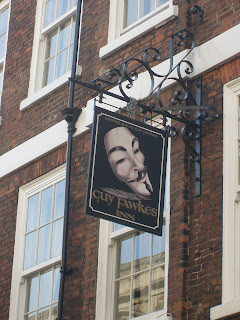Remember, remember the fifth of november.
Gunpowder, Treason and Plot.
I see no reason why Gunpowder Treason
Should ever be forgot.
- English rhyme
A penny for the old guy.
- A common request for money to spend on fireworks on Guy Fawkes' Day
Engraving by Crispijn van de Passe (c. 1564-1637), who had probably never encountered any of the men depicted.
People take pride in the strangest of things from time to time, and this pride manifests itself in a number of peculiar guises. Here in York the townspeople are very eager to celebrate or commemorate individuals who somehow are known to either the City of York solely or the kingdom at large. One of these commemoratees, clearly belonging to the latter category, is Guy Fawkes.
The commemoration of historical figures in most cases poses a number of problems, problems inherent to the very nature of history and its increasing remoteness. How should we, people of our own modernity, interpret or understand historical figures? There can be a number of answers, many of which come equally close to the truth and therefore have no greater claim to precedence than its peers.
For a person like Guy Fawkes the problem of presentation is perhaps more tangible than in most cases. As a Catholic in Elizabethan and Jacobean England Guy Fawkes was a member of a persecuted minority, a status that quite often elicits sympathy or even fervent support. The plot itself, an attempt to blow up the Houses of Parliament, can, depending on the judges and their inclination, be considered either an act of rebellion or an act of terrorism, or perhaps even both. Personally I find the latter term to have too much of a modern flavour, but I prefer this to the label "anarchist".
It is not difficult, nor should it be, to consider Fawkes' case to be worthy of support in one way or another, but whenever people with a just cause move a couple of steps too far, it becomes a very different matter. Therefore it is always interesting to see how such individuals are represented and to discover what has been emphasised. Here in York I have so far found three different approaches to the problem of representation. The three approaches are found to lesser or greater degrees in several cases, but for the sake of clarity I have divided them according to which approach I find most tangible in each case.
Representation through affiliation
By this I mean that whoever represents the historical figure chooses to emphasise aspects that the representer can identify with, either through a common ideology or cultural background. The best example of this here in York is found in the parish church of St Michael le Belfrey, a church named after its adjacency to the belfry of York Minster.
This is the church where Guy Fawkes was baptised, and the church staff has been very anxious to proclaim this affiliation as can be seen from the examples below.
Admittedly I find this preoccupation a bit bizarre, especially when they emphasise his Anglican background. They do have some very nice and informative flyers where his Catholic persuasion is pointed out and the background for the plot and his times are summarised quite neatly, yet to attract visitors they have chosen a slightly different tactic as seen above.
There are also postcards available for purchase depicting Guy Fawkes' entry in the parish register on the day of his baptism.
This is of course not a case of representation through affiliation in its purest form, but initially that is how the representation appears.
Representation to proximity
By this I mean that the figure represented is represented through his or her association with a geographical locality. This is of course the case in all three examples, but I think the best case of it in this array is the Guy Fawkes Inn.
The owners of the establishment has chosen to represent Guy Fawkes through the now iconic image from Alan Moore and David Lloyd's brilliant graphic novel V for Vendetta. Personally, however, I have quite ambivalent feelings towards this work, since Moore has chosen to represent Fawkes not as a Catholic but as an anarchist. This provides the reader with a skewed image, since Fawkes' motivation disappears into a general antagonism towards a nebulous system. I have the same problem with people leaning extensively on William Blake without taking his fervent Christianity into account.
As we shall see below this house in Petergate is not the only site claiming to be the birthplace of Guy Fawkes.
Representation through historicity
By this I mean that the figure is represented through his place in history, trusting his or her fame to be sufficient reason for commemoration. This has been the case in both the above examples, but when it comes to the Stonegate plaque this is first of all rather neutral in its tone - although with a nice tongue-in-cheek humour - and secondly it is a part of the general collage of information comprised of the numerous plaques throughout the city. In the cases of St Michael and Guy Fawkes Inn both utilised Guy Fawkes' fame first of all to attract visitors, whereas in Stonegate there is nothing to be gained except from displaying historical ties with the figure of Guy Fawkes.















Ingen kommentarer:
Legg inn en kommentar